Turquoise Energy News
Report #196
Covering
Research & Development Activities of September 2024
(Posted October 9th 2024)
Lawnhill BC Canada - by Craig Carmichael
[To subscribe: email to CraigXC at Post dot com ; request
subscription]
Website: TurquoiseEnergy.com
Month In "Brief"
(Project Summaries etc.)
* Tile Floor - Renewable Energy Symposium - Tinnitus Recap - Cabin
Construction - "Sand Battery" for heat storage - "For what it's worth"
In Passing
(Miscellaneous topics, editorial comments & opinionated rants)
- Detailed
Project Reports -
Electric Transport - Electric Hubcap Motor Systems
Unipolar EV Motor (just thoughts)
Other "Green" & Electric
Equipment Projects
* Cabin Construction
* 36V DC Wiring & Tinnitus Reduction
* Gardening: Fall harvests
Electricity Storage:
Batteries
* Double Compaction - Copper (Monel): It Works!
Electricity Generation
* My Solar Power System: - The Usual Latest Daily/Monthly Solar
Production log et cetera - Monthly/Annual Summaries, Estimates,
Notes
Here's another "Month in Brief" that isn't very brief. I started
the month by finishing the metal outside siding on my cabin.
And I did a couple more battery experiments - the double
compacted positive electrodes, tightly wrapped with waxed string. (More
in detailed report.)

Then, being unable to make another, perfected(?), zinc
electrode until my osmium powder arrives to pair with it (ordered in
May or June!), I dropped the batteries for now.
Tile Floor
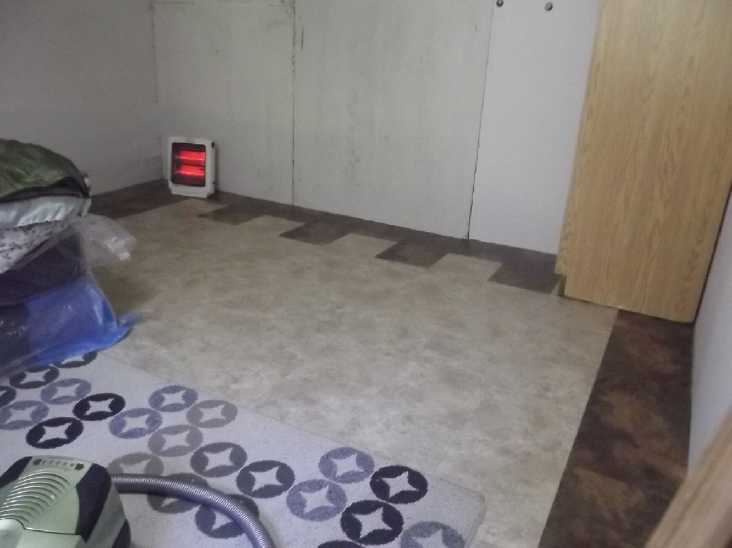 Friends sold me
some beautiful 12 by 24 inch vinyl floor tiles, 1/2 inch thick with
slots around the edges. They had been sitting around for some years,
new in boxes, and I was fortunate to get them for a great price. There
were enough to do my entire cabin!
Friends sold me
some beautiful 12 by 24 inch vinyl floor tiles, 1/2 inch thick with
slots around the edges. They had been sitting around for some years,
new in boxes, and I was fortunate to get them for a great price. There
were enough to do my entire cabin!
In the second week I spent a couple of days laying some in
the upstairs room of the cabin. Two edges have up slots, two down, and
they clip together by tapping with a rubber or wooden hammer until they
are flat and flush. No glue needed! I used a chainsaw brush to
carefully clean out each slot before putting them together, since they
won't tap down flush if there's any grit in a slot.
There were a few boxes of darker color tiles and I used
some around the edges. The original idea of a single dark line border
became dashed at the ends because they were intended to be laid lapped
like bricks.
Before I do the rest I have to build the floors to put
them on.
(BTW even off in the corner the electric heater seemed to make enough
AC voltage EMF to continue aggravating my tinnitus: the ringing in my
ears didn't quiet overnight when it was on.)
Swiilawiid Sustainability Society's 3rd Renewable Energy Symposium
 Swiilawiids are songbirds native to Haida
Gwaii.
Swiilawiids are songbirds native to Haida
Gwaii.
(I thought I saw one once but when I looked it up it was a warbler.)
 The symposium
The symposium
I spent my productive time in the third week getting handouts
and things ready for the renewable energy conference on the weekend of
the 21st & 22nd. The chief items were:
* A One page handout: Why 36 Volts DC is Better Than 120 Volts AC
36 V DC: A New Standard for Bedrooms, Living Spaces and Off-Grid
* 36 Volts DC Components and Appliances
(Mostly copied from TE News #194)
*36 Volt DC System Installation Suggested Practices -- about how
to wire up a DC installation
and on the side...
* Diagram & explanation of Open Loop Air Heat Pumping --
How to get COP 10 heating and heat a building almost for free
* Diagram of 'everlasting' copper-zincate battery
(or nickel-zincate, or manganese-zincate)
(Again I call it a "zincate" electrode because it is so different from
most zinc electrodes, and because the catalyst prevents the zincate
formed during discharge from converting to zinc oxide.)
And of course the main piece was my 36 VDC demo wiring panel.
When I was wiring it up I started thinking, "Gee, this is just like
wiring the cabin, except the wires are shorter!" But after all, that
was the whole point to making and showing the panel.
At the symposium I think mine was the busiest table. It
was almost non-stop on Saturday whenever there wasn't a talk going on.
People were interested to see the demo setup and take the handout. One
young lady said she wanted to be an electrician and I gave her a copy
of everything related to 36 volt wiring.
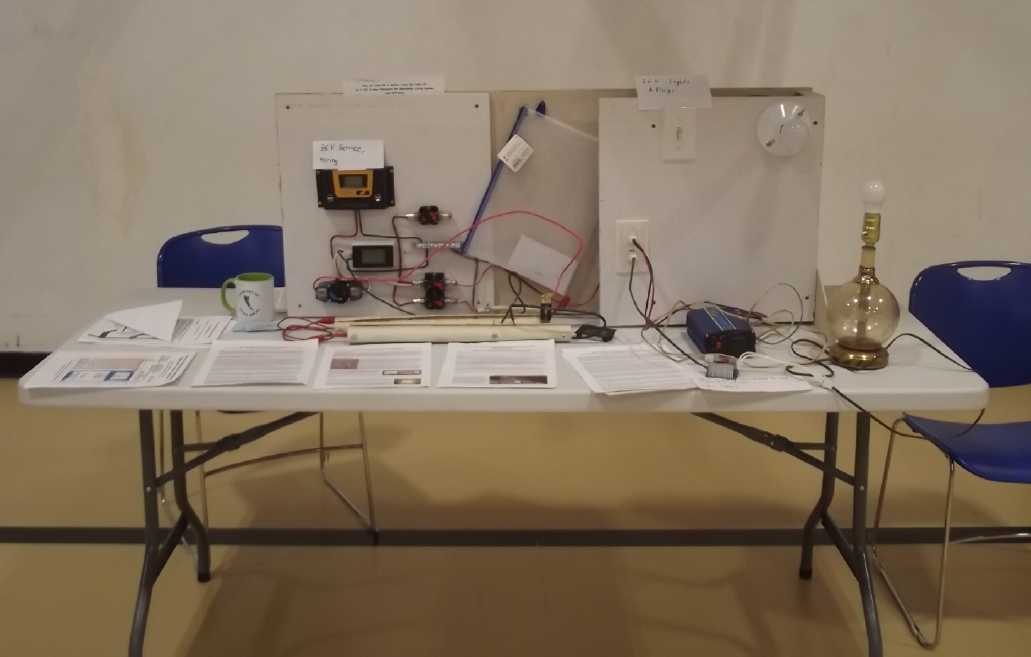 My table. Once there I thought to stick some
labels on the demo and borrowed a felt pen.
My table. Once there I thought to stick some
labels on the demo and borrowed a felt pen.
The two little tubes in front are 36V worth of 26650 battery cells to
power it.
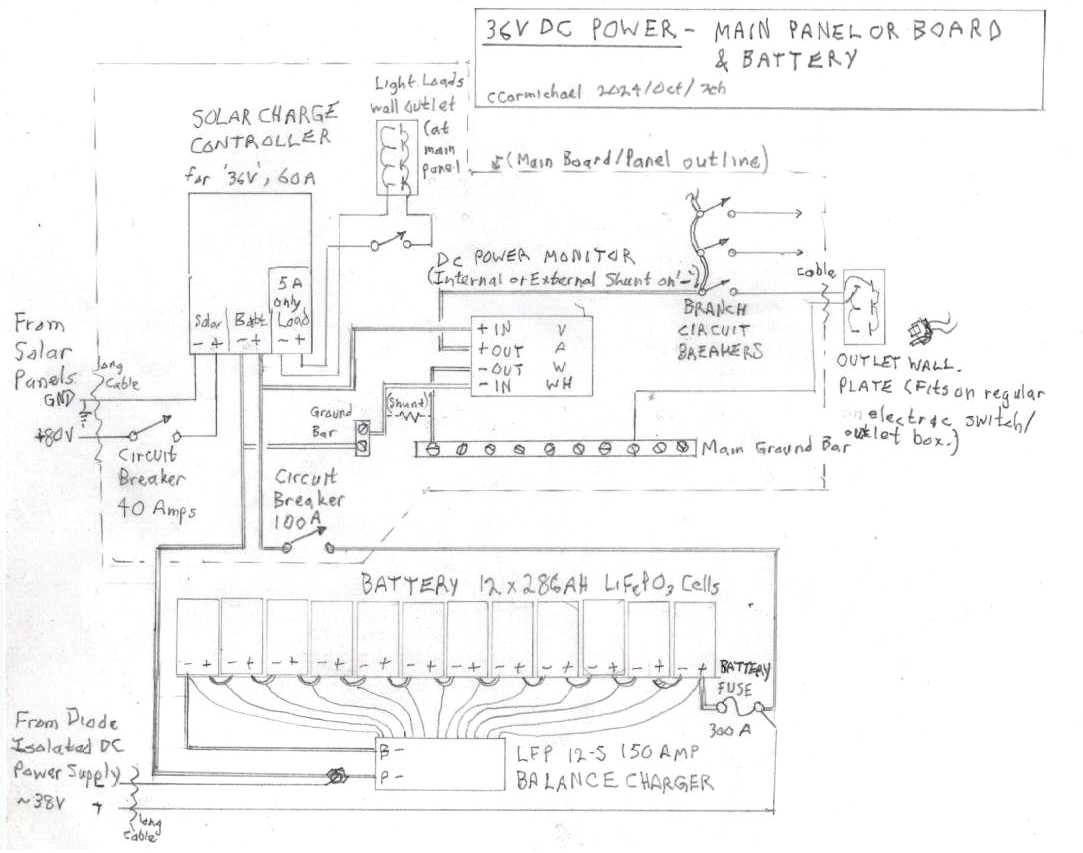 This schematic shows the circuits in my
cabin. It's very similar.
This schematic shows the circuits in my
cabin. It's very similar.
(The "Load" outlet on the solar charge controller can be programmed to
come on and off, and
will shut off if the battery voltage gets below a chosen setpoint.
However, although the controller
is "60 amps", the load output on this one is only 5 amps, so it can
only handle light loads.
Furthermore, the negative is switched instead of the positive, so the
negative can't be grounded.)
I learned something of interest at the BC Hydro table: In
diesel powdered "micro-grid" locations such as Haida Gwaii, BC
Hydro will grant up to 75% of the cost of a new home solar installation
feeding the grid, plus up to 75% for a battery system that will
smooth power usage on the grid, up to a limit of 100 KW and 75,000 $
each. It has to be contractor installed. The reason for the grant is
that it costs much more to supply electricity from diesel powered grids
than the (province-wide) 12¢/KWH the customer pays - I think I heard
about 61¢ at the meeting. (or it was
"subsidized by" 61¢, making the total 73¢?) So it pays BC Hydro to
reduce the demand instead of to increase it. The offer is so attractive
I could see putting up another 16 or 20 solar panels on the house roof
if I can afford the 25%. I'll have to see about a contractor and how
much of the work I can do myself. I don't think my "class RB electrical
license" (probably long expired) would cover this.
On Sunday morning I went on a tour of the new 4,060
solar panels installation beside the runway at Masset Airport. (Largest
in BC?) I was surprised to hear it wasn't actually working yet as the
panels have been up for a while, but there was a lot of other equipment
still being installed - huge transformers, fat wires (many "0000's"
AWG) and cables to the main diesel generating station just on the other
side of the airport, which the solar power is to supplement and reduce
the fuel consumption of. IIRC it's supposed to be up and running in
October or November. DC output coming from the strings of solar panels
was 1500 volts - a far cry from my 80 volt two-panel strings and
reduction to 36! I learned that Haida Gwaii uses half the fuel of all
the diesel generating installations in BC. This solar installation
should reduce it on the north grid by 9%. It's a start! (The south grid
is 60% hydroelectric, but it depends on how much rain there is as the
lake feeding it isn't very big.) By the present cost to generate
electricity we should be paying 61 cents/KWH. Less than I had thought,
actually. I suspect that may not include costs of maintenance and
repairs on the grid.

Two of more than a dozen rows of solar
panels at Masset Airport.
(Me 2nd left, red jacket)
Tinnitus Recap
Segue... A lady came to my table and said she had worked in the
Skidegate Health Clinic for decades. She said ALL the elders in the
village had tinnitus, and that it was incurable. I said that hearing
loss seems to make one more susceptible, and that as we get older we
tend to loose hearing. The only cure was to get away from the AC
electric fields, and that since the ringing can take days to fade and
we're Very rarely away from electricity that long, it was hard to
recognize AC power fields as the cause. (How it works I don't know but
it appears to be stress, induced at the cellular level, which also has
health effects other than tinnitus. See GreenHomeInstitute.org) A
couple of people asked about WiFi and cell phones. Microwave radiation,
with especially cell phones sometimes causing cancer, is for sure a
valid and poorly studied concern but it's a separate issue from
electric power, house wiring and tinnitus.
It's only been somewhere over a year since I realized
thanks to an astute observer that my perpetual and very loud tinnitus -
and obviously that of countless millions of other people - was caused
by AC power electric fields, and that few people are ever away from it
long enough (days) and far enough to find the ringing has faded away.
Even then, like me in my week long off-grid camping experience of long
ago, one may still not figure out why it has gone. At my point of
realization, my life-long and more recently increased tinnitus
experiences started to fall neatly into place.
Next I learned that the effect of the AC voltage field on
the body can be measured by measuring the induced "Body Voltage" with
an ordinary AC voltmeter, between a ground point and wetted fingers.
And then I ran across "Green Home Institute". They had come up with
standards for this that seemed absurdly strict: to be "trivial" or
"non" exposure the body had to measure under 10 millivolts, when levels
inside my house were mostly over a volt or two or three. At first I
thought that the high levels were because the house was much too close
to the 14,400 volt power line, but grounding the metal roof and putting
up grounded chicken wire shields around outside walls, to my confusion,
only helped somewhat. To a large extent it was the lavishly wired
"modern" house itself that was the problem - only 120 and 240 volts,
but right there everywhere in the floor, the walls and the ceiling.
As these things were dawning on me I was just at the
point of starting to wire my new, unfinished cabin. I bought a circuit
breaker sub-panel to feed a few circuits. It was at an ideal space
since it had a metal roof and metal outside wall covering. I grounded
it at all four corners and in the middle of the long walls, grounded
the metal doors, and put 2 inch mesh chicken wire (also grounded) in
front of the windows to make it a "Faraday Cage" and block the field
from the power line. But from the small effects of shielding the house
from the outside, I finally realized that would do me little good if
there was unshielded AC wiring inside. At first I was going to run
shielded wires in the walls, but even a power cord on an appliance
(whether or not it's turned on) is an unshielded cable emitting a
voltage field, and it just wasn't going to be good enough. For the
susceptible, most any nearby 120 VAC = tinnitus.
So finally I changed the whole plan and decided to wire
the cabin with 36 volts DC instead. For absolute essentials I put in
one 120 volt outlet in one corner by a door, with mostly shielded
wiring, and plugged the cabin into the house with a very long extension
cord. This allows the grid ties to send their power to the house as
well as to run power tools and other appliances. For the summer the 36
volts was entirely solar powered, but after a cloudy streak I connected
a 10 amp power supply set to 38 volts in the far corner by the one AC
plug, to keep the battery partly charged while running 200-300 watts of
electric heat at 36 volts overnights, regardless of sunshine. As my
monthly solar logs show, there hardly is any sunshine
(scroll to near bottom) here in the northern west coast winter clouds,
with short days and long shadows.
When the bedroom was just barely far enough finished in
mid July (far further ahead than the rest of the cabin), I got a new
bed and started sleeping in it. Soon it was quite obviously reducing
the ringing in my ears: by morning the sound would be less intense than
the previous evening. I started spending more time there, for example
doing my writing there as well as sleeping. But when I had to spend
time in the house, or when I had to drive places (under the 14,400 volt
power lines by the highway), it got worse again far more quickly than
it got better. So household chores like doing the dishes get put off
and put off as I hurry to get out whenever I can. The more time I spend
in the cabin the quieter my tinnitus gets, and it can dull to a mild
noise and quiet lower tones instead of a piercing tone. But I don't
think I'll be rid of it unless (until?) I'm pretty much living in the
cabin and not in the house.
At the same time, occasionally having an AC electric field
inside the cabin emanating from a an extension cord with power tool (or
whatever) accidently left plugged into the one receptacle downstairs
showed that the GreenHome Institute's ratings, so roughly defined as
they appeared to be, were close to the mark. My tinnitus wouldn't be
better by morning and an AC voltmeter would show a body voltage at the
bed in the range of only 40 or 50 or 80 millivolts. Then I'd go
downstairs and find the culprit. Probably 20mV is on the border. Higher
than that will cause tinnitus or at least prevent it from subsiding.
The only way to get such a low figure for human inhabitations is to
keep AC power well away from bedrooms and living spaces where people
spent much of their time, and to shield whatever AC power cables are
still necessary for (eg) kitchen and laundry.
I should point out that all this is My experiences with My
level and symptoms of tinnitus. And sometimes I suspect I may not have
a very good ground with the voltmeter probe. So others are likely to
have differing results, but perhaps this is a starting point.
===
Well, I wrote this earlier and now it doesn't fit nicely into the rest
of the narrative. Sme of it is just a repeat. I'll add it in here
anyway.
On the night of the 15th when I went to bed I noticed my
tinnitus was really bad. Why? I had only driven for 1/2 hour, in the
morning, and spent a fair part of the day in the cabin. Wait...
Uncharacteristicly, I had been on the phone in the house for 2-1/2
hours in the evening on four separate calls. Of course I removed my
conductive fibers tuque for the duration to hear the phone well. Right
in the worst AC fields for hours with no protection at all! It was
still quite bad in the morning. It shows that the tuque, while no cure,
is better than nothing.
Before knowing the cause, I used to just have to shrug it
off and wonder why it was usually so bad and sometimes much worse. And
of course I didn't know to even try to get out of AC fields. I
suspected something about the house since it was so much worse than
when I lived in Victoria and I kept looking for some audio irritant -
what, what, what? The idea that it was the AC house wiring itself as
well as the single high voltage power line outside, I dismissed as
ridiculous. (My 1879 house in Victoria had much less wiring in it than
more recent houses, and the three phases of the power poles outside,
being more or less in line from the house upstairs (and doubtless only
7200 volts), probably more or less cancelled out. All explaining why my
tinnitus wasn't As bad living there.)
Cabin Construction
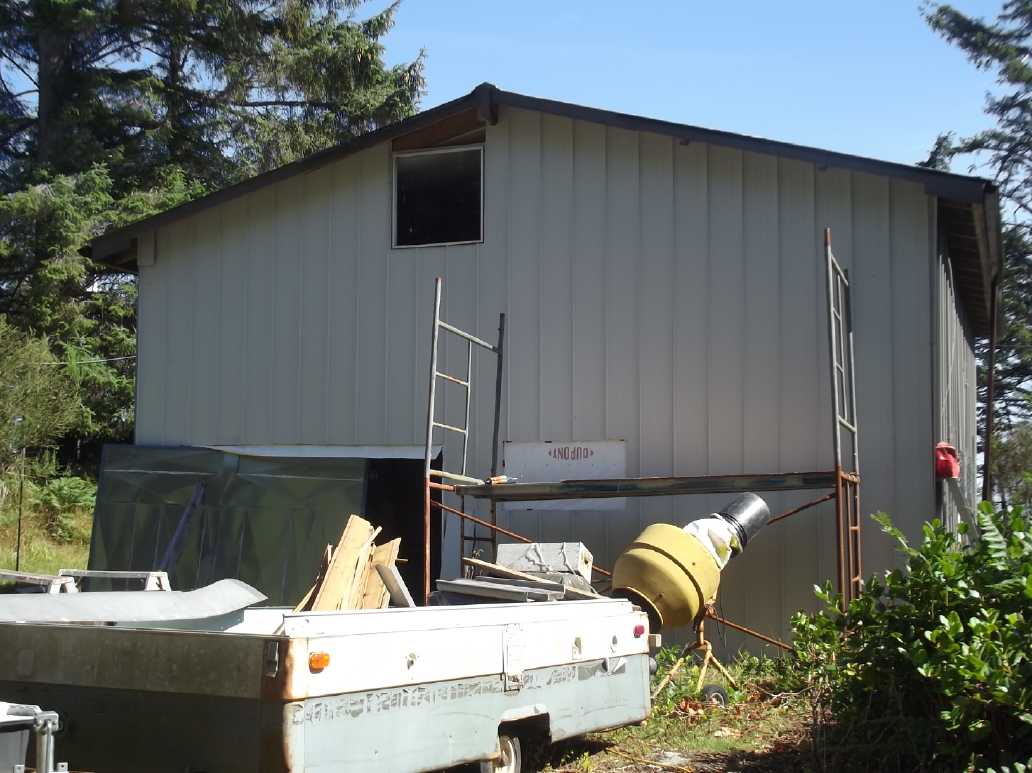 Last wall Done! (Foto Sept. 3rd)
Last wall Done! (Foto Sept. 3rd)
I keep wondering how I will ever finish the whole cabin.
Oh well, in 2018 the cabin was a roof on posts, I had spruce logs on
the ground instead of lumber. I spent a year inventing the handheld
bandsaw sawmill and another summer cutting up the logs. Just this
spring there was still no upstairs room or stairs and now I'm sitting
in here typing, and after five years I've finally finished the facing
on the last outside wall. One little piece at a time, I guess! The
remaining work on windows and doors should be next, I suppose, until
the little birds aren't flying in and out and it doesn't get cold so
fast at night. hopefully before it gets too cold and wet to work on
outside things. I've decided my goal is to finish the essentials before
July. Then I started thinking about storing heat in the sand under the
floor... and now a whole system of water circulation pipes has to be
dug in before the floors get made?
"Green" Heating: Open Loop Air Heat Pumping ("OLAHP") ... and (NEW
idea): Hot Sand Floor Heat Storage?
On about the 21st I decided to install the OLAHP in the
cabin instead of in the house. The installation isn't far enough along
that it would be difficult to move. (Maybe it's well that I stopped
working on it over the summer?) In spite of having to use an AC
refrigerator compressor until some time when I find time to make the
special rotary compressor-decompressor (as a 36 volt DC unit) to get
the COP up to around ten, I could still mount it way over in the corner
by the AC plug and keep the EMF field low in the bedroom and 'other
end' areas.
On about the last day of September I looked at a youtube
suggestion for a "Sand Battery", and then saw a couple more. It's not
electric. The idea is that sand can be heated, eg by solar energy, as a
store of heat for later building heating. It can store a lot because it
is cheap and safe and a large volume of it can be heated to hundreds of
degrees, whereas water would boil. (Apparently dry clay can work well
too.) It caught my attention that a cubic meter of sand heated to 500
C, in cooling to 50 C, can release 166 KWH of heat. That would (eg)
supply 2 KW of heat for over three days.
I had already been idly thinking about the sand floor of
my cabin. My plan has been to dig down and insulate for a foot down all
around the edges with polystyrene foam rather than insulate the entire
wooden floor above the sand. The sand underneath would thus be somewhat
isolated from the outdoor earth and would be near room temperature. But
if this sand could be further heated, it would be a "sand battery". To
go down a foot for the 24 by 32 foot cabin would give about 20 cubic
meters of fairly isolated sand, over 30 tons. This large mass wouldn't
need to be heated to water's boiling point to store a Lot of heat. That
would be a lot easier as common materials could be employed and it
wouldn't lose heat very fast even with much less insulation.
Formula: Joules = m * k * deltaT
where:
"m" is mass in Kg ; weight of sand = 1600 Kg/m3
"k" is around 830 Joules/Kg/° for sand
deltaT is the temperature difference: eg, if the sand is heated
from 40° to 90° it's 50
Joules is the energy stored or released.
If I choose 40°C as the lowest effective temperature for the radiator
and 90° as the maximum we want the water, sand and insulation to get
to, then:
20 cubic meters is 3200 Kg of sand, and we raise it from 40° to 90°C
Joules = 32000 * 830 * 50 = 1,328,000,000 Joules
1 KWH = 3,600,000 Joules
so 369 KWH
If supplying 2 KW of heat that's 48 KWH/day... 369/48=7.7
days of heat.
The best means to get the heat into the sand would seem to
be to run a lot of water pipes through it and pump hot water through
it. The water could be heated by solar PV (via an electric water heater
element in the water) or, I am thinking (with our cloudy winters of
short days), by a woodstove. Once the sand was heated, water would
again be pumped through it, this time into radiators in the space. It
might be that one would run the stove for a whole day (or two) and then
"coast" for a week on the heat in the sand before the radiators weren't
warm enough. or longer if the sun was helping or it wasn't very cold.
It seems to me this system, even for 90°, would have to be
separate from the OLAHP, which counts on driving a minimal rise in
temperature to attain its high COP's. I would happily put off a "sand
battery" project until some hypothetical future time, but I would need
not only to insulate the sides to a foot down, but dig in and lay about
1000 feet pipe all around in the ground -- surely before I put in the
floors! Yikes, how am I ever going to finish this building? I have some
lengths of pipe, but I might as well use PVC "1-1/4 inch irrigation
system pipe" throughout, so all new pipes and fittings.
Maybe I could start with putting down the first 1/4 of the
floor and piping just the other half or 3/4 of the ground when I get
that far? But on October 5th I suddenly got the idea that there might
be some simple handheld trench digging tool, something like a
rototiller, to make it fast and easy. There were some, going down to 18
inches, but they were rather costly, and I started thinking the handles
would be in the way near the walls. Then I ran across a hand trench
digger from Lee Valley tools, something like a hoe shaped to scoop sand
out of the trench, for just 72$. I ordered one. I wouldn't want to try
digging through grass turf and gravel with it, but in sand it should be
a fast hack. There are plenty of tasks to complete until it arrives.
And I should order the pipes and elbows, too!
So the components would be about 1000 feet of pipe -
probably about 80 PVC '1-1/4 inch irrigation system' pipe (12 feet
each) and fifty 90° elbows to zig-zag the pipes back and forth in a
long string. A water pump to circulate the water through the pipes. A
lot of copper pipe looped around inside a woodstove. (and a woodstove.)
An electric water heating element to make heat from the solar panels. A
hot water radiator, maybe with a DC fan, to disperse the heat from the
sand into the cabin. And a bunch of little things to go along with
those.
Or maybe instead of a radiator I'd just need hot air
registers in the floor? After all, all the sand under the whole floor
will be warm or hot.
October 8th: I think I'll just pipe under the garage and the other
north quarter of the building - half in all. That way I can do the
south side floors, use half as much pipe, and try and save money to pay
for it while I'm doing the rest.
For what it's worth...
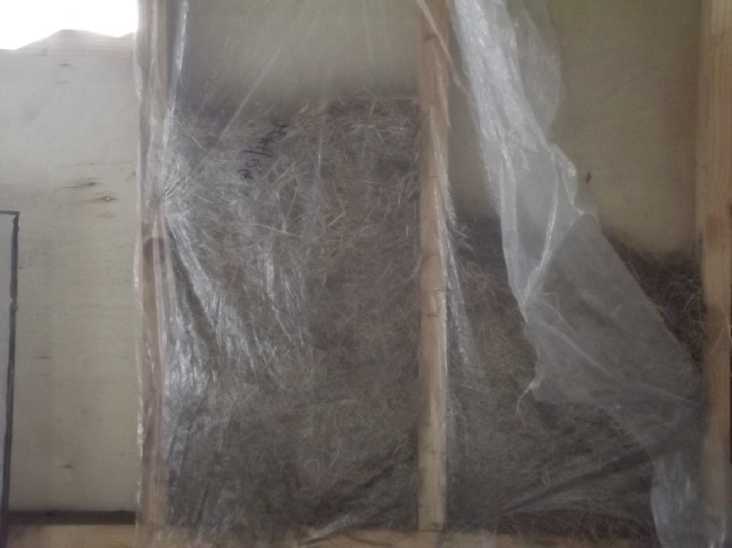 A couple of years
ago I had the idea to insulate the cabin with dried lawn grass
clippings. As a loose fill it's about R3 per inch, slightly lower than
fiberglass, free, and biodegradable. [TE News #169, #170] I
collected 50 large bags over the summer. Then I decided it wasn't good
enough and I would use cellulose fiber (R4 per inch). I started using
my bags of dried clippings for mulch and to put in the chicken coop. By
the time I discovered I literally could not buy cellulose fiber
insulation in northern BC, I had used most of the clippings and was
stuck with using fiberglass.
A couple of years
ago I had the idea to insulate the cabin with dried lawn grass
clippings. As a loose fill it's about R3 per inch, slightly lower than
fiberglass, free, and biodegradable. [TE News #169, #170] I
collected 50 large bags over the summer. Then I decided it wasn't good
enough and I would use cellulose fiber (R4 per inch). I started using
my bags of dried clippings for mulch and to put in the chicken coop. By
the time I discovered I literally could not buy cellulose fiber
insulation in northern BC, I had used most of the clippings and was
stuck with using fiberglass.
But I had done a test fill. The grass, very loosely
filled, had seemed to sit in the wall cavity without settling down any.
(Settling would leave a gap at the top of the wall.) Then I removed the
plywood. Of course the plastic bulged and it settled some.
Looking at the fotos from #169 (May 2022) it seems the
grass has shrunk down a lot, so it probably wouldn't have worked very
well - I'd have had to open the walls and top it up more than once. Or
dry it more thoroughly before starting. But no mice have gone into it
or anything, even tho it's open at the top. With metal on the outside
of the wall and gyproc inside, I wasn't concerned about fire.
(Polyurethane foam is flammable too, but it is used.)
On the other hand, since the cabin is all metal on the
outside anyway, I figure I might as well make it as fireproof as
possible in case of a forest fire. Loose fill cellulose fiber is
actually more fire resistant than fiberglass, but I have my doubts
about untreated lawn grass.
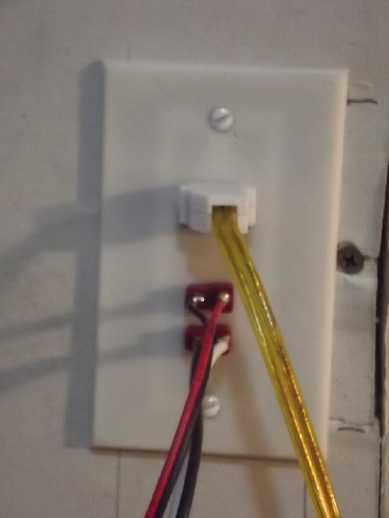 My 3D printer
being on the fritz, I have some 36V plugs with no shell covering them.
I plugged one in. My thumb and finger were touching both plus and minus
pins and after I thought "Ooh, my fingers were damp." But I didn't get
a shock. No one would dare even think to use a plug with bare wires
with 120 volts, where such casual mistakes can potentially be fatal! I
suspect I'd have got a shock at 48 volts.
My 3D printer
being on the fritz, I have some 36V plugs with no shell covering them.
I plugged one in. My thumb and finger were touching both plus and minus
pins and after I thought "Ooh, my fingers were damp." But I didn't get
a shock. No one would dare even think to use a plug with bare wires
with 120 volts, where such casual mistakes can potentially be fatal! I
suspect I'd have got a shock at 48 volts.
In
Passing
(Miscellaneous topics, editorial comments & opinionated rants)
Scattered Thots
* I wonder whatever happened to 6-12 mosquito repellent?
ESD
(Eccentric Silliness Department)
* Faces:
- A monohedral has just one face (like a sphere?)
- A bihedral has two faces (sheet of paper(?)
- A trihedral has three faces (like, um, uh...)
- A cathedral is a complex geometric form having stone arches and
stained glass windows.
* A Klingon at a textile factory: "Today is a good day to dye!"
* Five grams equals one pentagram.
* Adding one gram plus one gram and getting a number other than two is
a grammathical error.
"in depth reports"
for each project are below. I hope they may be useful to anyone who
wants to get into a similar project, to glean ideas for how something
might be done, as well as things that might have been tried, or just
thought of and not tried... and even of how not to do something - why
it didn't work or proved impractical. Sometimes they set out inventive
thoughts almost as they occur - and are the actual organization and
elaboration in writing of those thoughts. They are thus partly a diary
and are not extensively proof-read for literary perfection,
consistency, completeness and elimination of duplications before
publication. I hope they may add to the body of wisdom for other
researchers and developers to help them find more productive paths and
avoid potential pitfalls and dead ends.
Electric
Transport
Unipolar
EV
Motor
I keep being tempted to take the 7.5 HP (230 V * 25 A =
5600 W) Baldor motor apart and changing it to 38 V, 150 A = 5600 W.
(Okay, it wouldn’t make anything like a “muscle car”. But especially
counting short burst “above the rating” power that electric motors
have, I think it would be enough to put the lightweight Chevy Sprint on
the road.) There are six slot pairs per phase, 18 coils total. If each
phase was wired as six parallel coils instead of six in series,
230V/6=38V. That gives the very same voltage and current flowing
through each coil for the same power. Performance should be identical.
It just needs really heavy (~#2 AWG) wires running the few feet from
the battery and motor controller instead of #10 AWG wires running
across a building. The chief motivations for the project would be (a)
to get the Sprint on the road soonest, and (b) to demonstrate a 36 volt
EV to the many people who think lethal voltages are absolutely
necessary for the high powers needed to run an electric car.
===
Then of course I’d even more love to do the
ultra-efficient 12 coil, unipolar, axial flux, BLDC "Electric Hubcap"
motor with a Hallbach configuration magnet rotor, probably instead, for
the same car. That would be the most efficient and highest torque… and
the most ambitious project. (How long ago it seems that I made the
Electric Hubcap and Electric Caik motors and controllers! The new plan
is based so closely on those. I have the components for the motor and
the essentials for the six-phase unipolar motor controller design. How
was it so much easier back then?)
At the same time, I have a number of other valuable but
major, time consuming projects I want to do at the same time. I feel
like I just can’t ever do them all. (If I’m going to pick one of these
two, the unipolar Electric Hubcap is probably a more worthwhile project
– one to point out a better way into the future rather than just to run
a car.)
A glutton for punishment, I went and refreshed my memory
on what I already had done. It was a little farther along than I
remembered. When I learned of the Hallbach magnet rotor configuration
idea I had had to increase the rotor diameter a little to accommodate
the additional magnets. I thought I had made the actual rotor too
small, but apparently it was cut after the size change. The
next task then is the magnet placement jig. I remember that as needing
to be changed – the scale wasn’t quite right or something, and I would
have to redo the G-code from the spreadsheet. Ah yes -- it was that I
couldn't use a 1/4 inch router bit and had to go with 6mm to match the
router collet. All the numbers are off by .035 inches. Ug!
(Well, other needs have put this project to rest yet again.)
Other
"Green"
&
Electric
Equipment
Projects
Cabin
Construction

The siding was finally finished about the start of
September
(Windows, doors, trim yet to do)
 Having got the
first 11 boxes of floor tiles, I spent two days installing them in my
cabin bedroom [8th & 9th]. These were 1/2 inch thick interlocking
vinyl tiles. Slight texture so as not to be slick when wet. No glue,
"cushiony" with a small insulating air space, "waterproof". Set them
side by side and pound the groove of one into into the tongue of the
other with a rubber or wooden hammer until they are flush. (You can pry
them apart again if necessary. Any slight bit of grit in the grooves
they won't go down flush.) Of course it made a tremendous difference to
the whole appearance of the room from rough T & G boards. And it
covered over knot holes in the boards.
Having got the
first 11 boxes of floor tiles, I spent two days installing them in my
cabin bedroom [8th & 9th]. These were 1/2 inch thick interlocking
vinyl tiles. Slight texture so as not to be slick when wet. No glue,
"cushiony" with a small insulating air space, "waterproof". Set them
side by side and pound the groove of one into into the tongue of the
other with a rubber or wooden hammer until they are flush. (You can pry
them apart again if necessary. Any slight bit of grit in the grooves
they won't go down flush.) Of course it made a tremendous difference to
the whole appearance of the room from rough T & G boards. And it
covered over knot holes in the boards.
I calculated that each 1/4 of the building (just under
12*16 feet) needed exactly 8 boxes of 12 tiles. So I got 32 boxes of
tiles total, for less than 1/2 price, plus one extra box to accommodate
cutting mistakes, of which I made one in the bedroom.)
But there are still a zillion things to do in the bedroom
and the rest is hardly started, so the rest of the tiles are bound to
sit waiting for a long time.
[23rd] I had been thinking it would be a big job to get the big stack
of lumber out of the cabin. I had stacked it inside as I used up the rest of the metal that I had used to cover it
with to finish the outside walls. I thought I could use it up doing the
three floor sections, but then had decided to do the floor later. Now
there was a wall in the way. Wait a minute... there was the unfinished
window hole, covered with tyvec! I cut the tyvec to expose the hole and
screwed a piece of metal to the bottom to slide boards across. But it
was raining.
[24th] No rain! I pushed the lumber out the window, stacked it on half
palettes (palettes that I hadn't finished cutting into firewood days
previously!) next to the other lumber stack, and found enough sheets of
scrap roofing to cover it all. Half palettes are more wieldy than whole
palettes. I got it all done in one morning.
Now... about that WiFi connection. If I had WiFi I could
spend more of my time in the cabin. I had turned on a router in the
window greenhouse facing the cabin and found (to my surprise) that it
almost connected even through the metal walls. It repeatedly said
"connection failed", then tried again. So close, yet so far!
Then I got the idea for the under-floor sand "battery"
heat storage. But going into October finishing windows and doors seems
like a higher priority.
36V
DC
Wiring
&
Power
-
&
Tinnitus
Amelioration
[10th] I finally got around to wiring up a DC power monitor. No more
guessing how much power I've used for overnight heating and whatever
else.
I thought I had some 100 amp ones with external shunts,
but it turned out those were an older LED model meter that only showed
voltage and current, not cumulative amp-hours or watt-hours. I kept
meaning to order one like in the house installation, but kept
forgetting. I also found that I had a bunch more of the internal shunt
20 amp monitors than I thought, and finally I settled for one of those.
I may upgrade it later, but even now, 250 watts of electric heat is
only around 7 amps, so it's actually sufficient unless I start using an
inverter for a coffee maker, microwave oven or something in the cabin.
Or AC power tools running on the DC.
I took the 'antique' iMac out to the cabin and was running
it with an inverter, writing This on it. Running, it drew 50-75 watts.
Asleep it wasn't much but the inverter itself (as seen at the new power
monitor) was 18 watts continuous. I took a nap and when I got up I
thought my tinnitus was louder than it should be in such an electricly
quiet environment. The computer was on Sleep with the inverter On, and
I measured my body voltage. Hundreds of millivolts instead of a just
few! I almost might as well be in the house! I shut down the computer
and turned the inverter Off. Sure enough, back to 7 mV AC.
That was it for me running an AC fed computer in the cabin! When I took
the power cord back into the house, I noticed it had at least two
breaks in the alume tape 'shielding', which meant it was only shielded
up to the first break (unless the two tape ends happened to touch), and
the other 2/3 of the cord wasn't. As the cord flexes, the tape rips. So
much for using alume tape to make power cords shielded! Hmm... one
could run the copper wire through the whole length to bridge such gaps.
Luckily my new "notebook" laptop had arrived in the mail
the day before. It ran on a 12 volt, 2 amp power adapter... with, of
course, a round plug that didn't fit any other 12 V power adapters.
After giving up looking I ran across one the same on a 5V power adapter
in a drawer. (Later I found more 12V plugs the same.) I chopped it off
the power adapter and wired it up to a DC to DC converter. On the input
of course I wired up a T-plug to fit a 36V wall receptacle, and I set
the output to 12 volts. The power monitor showed it was using all of 6
watts!
[11th] I installed Ubuntu Linux on the "notebook". Then the internet
went down and I couldn't load software I needed. I copied Sea Monkey
off the Lenova so I could edit the newsletters on it, out in the cabin,
with no AC fields around.
[13th] When I can spend more time in the cabin with the AC electric
fields blocked out, as I had hoped and come to expect, the ringing in
my ears generally and very gradually becomes substantially less
intense. But now whenever I drive somewhere, I notice that it is
definitely worse, especially if I’m on the road a couple of hours on
one day. I’ve been blaming it on being under the power lines wherever I
drive, and saying that perhaps one just doesn’t notice it in a gas car
because it’s noisier. I can hardly ground a meter and measure my body
voltage when driving along in a car, but the potential for making EMF
noise right by the driver in an EV seemed large. Then I took some trips
in the Toyota Echo (petrol) and it seemed just as bad. So it must be
the power lines after all. I guess the firewall and all the metal
encloses whatever fields EV cars make, and after all the wires are very
short. High voltage power line fields come right through the windows.
[14th] I had mounted the "LiFePO3 12S" 150 amp balance charger at the
battery last month. I (finally) wired up the 13 sense connections and
connected it. Up to this point, the charge to the battery from the
15/30 amp balance charger had never been over about 15 amps, 600 watts.
The sun was out and now it went up to 22.5 amps, 900 watts. Derating
the 305 watt solar panels to the typical 75%, that's around the maximum
they should put out! It will definitely recharge faster after running
250 W of heat all night... when it's sunny. A couple more solar panels
would improve things, but the cabin gets a lot of tree shadows in the
winter. Solar panels at the house would need very long, fat cables to
feed the cabin.
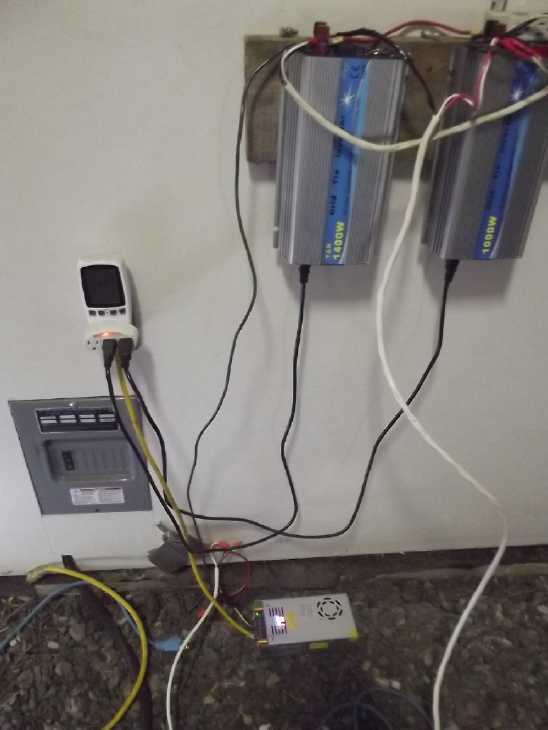 [15th]
The
battery
got
rather
run
down
in
the night, below 36 volts. I can't depend on solar for
heating in the cloudy winter months with short days and long tree
shadows obscuring the panels. But rather than being driven into the
house or turning on a noisy AC heater, I "installed" a 10 amp power
supply on the one outlet by the door, set to 38 volts. I used a diode
with a heat sink to isolate the supply, which fed the battery with a
long DC cable. As the battery drained from 39.9 volts down to 38.0, the
power supply would draw from the AC line to keep it from dropping
further. I could turn on all the small heaters for the night "with
impunity". If the sun could bring it back up to 39.9 volts, then it
would be mostly solar the next night.
[15th]
The
battery
got
rather
run
down
in
the night, below 36 volts. I can't depend on solar for
heating in the cloudy winter months with short days and long tree
shadows obscuring the panels. But rather than being driven into the
house or turning on a noisy AC heater, I "installed" a 10 amp power
supply on the one outlet by the door, set to 38 volts. I used a diode
with a heat sink to isolate the supply, which fed the battery with a
long DC cable. As the battery drained from 39.9 volts down to 38.0, the
power supply would draw from the AC line to keep it from dropping
further. I could turn on all the small heaters for the night "with
impunity". If the sun could bring it back up to 39.9 volts, then it
would be mostly solar the next night.
[16th] When I got up the sun [clouds] was supplying 2.0 amps, the power
supply 2.5 amps, and the battery still .3, with the heaters drawing 4.8
amps.
I added a 38V DC power supply to keep the battery from getting low if
there's not enough solar power.
(Also when the battery is low I turn off the two grid-tie micro
inverters so the DC charge controller gets all the juice.)
At the wall is a diode (with a big heatsink) so power can't feed from
the battery into the power supply.
One white cable connects the solar panels to the charge controller
across the room,
the second one connects the DC power supply via the diode - a
backup for when there isn't enough solar to keep the battery charged.
(A 100 foot cord connects to the AC in the house.)
(Yes, now it all needs to get properly mounted, "installed", with the
cables run behind the wallboard and under the floor to be.)
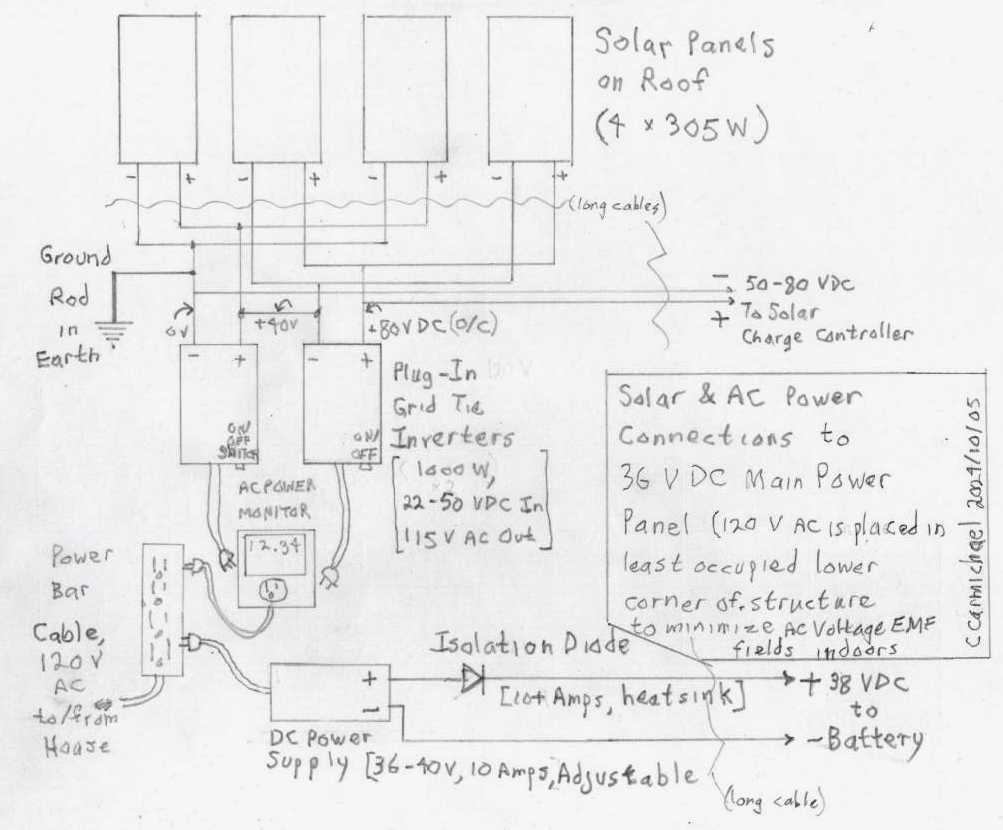
Schematic of the above "AC Corner"
+ Solar Panels
(Yes, it all needs to be redone with everything installed and cabled
nicely. When I get to it.)
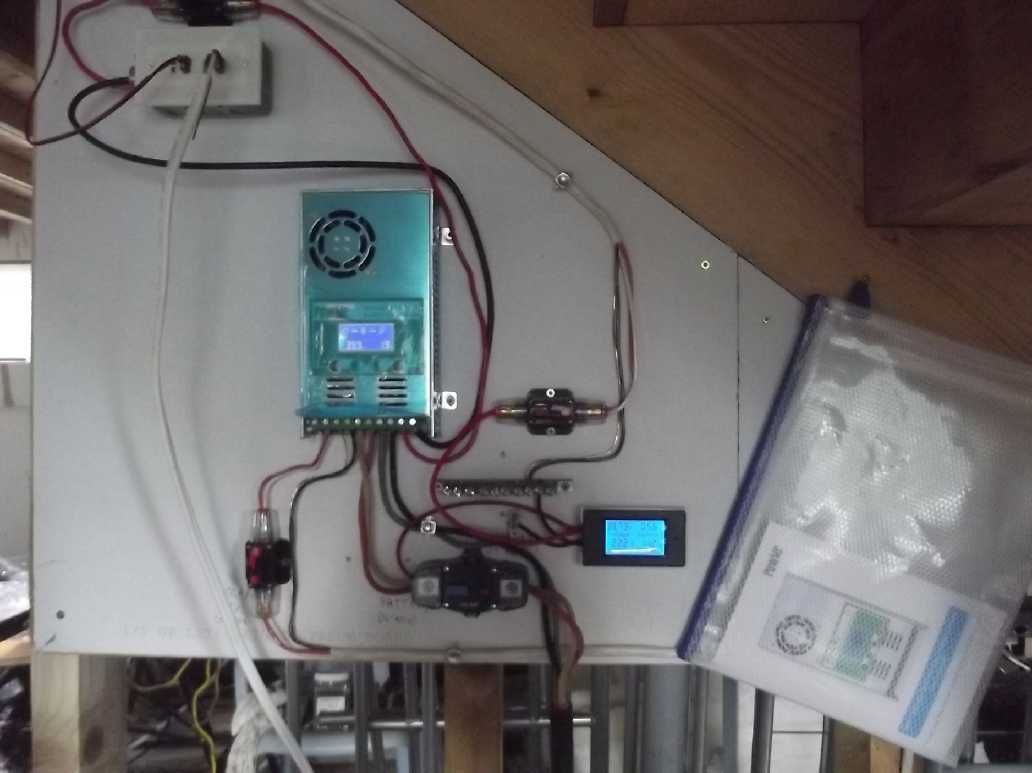
New foto of the
cabin 36V DC main panel
(I try to do neat wiring, but I keep adding and changing things,
then other things need moving.)
 For next time, here's a schematic
including the things I initially forgot or neglected
For next time, here's a schematic
including the things I initially forgot or neglected
Gardening
Fall Harvests!
Both the apple trees I put in in 2017 finally had good
crops. Previously they had made just a few apples, if any, per year.
The size of the apples is disappointing, but they were a little bigger
than what these trees produced in prior years. The new Northern Spy
tree had no fruit, again. I've been thinking I should have got
something with lots of big apples for making applesauce, like Yellow
Transparent, which my Mom had at her previous house. (Unfortunately I
had forgotten that name for many years until my brother reminded me of
it recently.)

Liberty Apple Tree

Empire apple tree

A little bigger than crabapples.
The Empire (left) are Not good keepers.
A lot of the garden vegetables (carrots, beets, turnips,
lettuce some of the bush beans) got choked by a profusion of weeds and
did poorly. The blueberries were sparse probably because I planted mint
and it spread all through them, taking light, water and nutirents from
them. Cabbages and cauliflowers have been very slow and no brocolli.
(These things seed themselves in the greenhouse, but I think I should
buy some new seeds - they seem to have cross-bred and aren't behaving
as one would expect. Cabbages that don't form a head, cauliflowers that
grow little bunches instead of a big cluster...)
I had good peas, good beans - headed for a kilogram of
each in the freezer (not counting the many I ate). The onions weren't
very big, but passable, and I have a good box of small onions stored
away. Lots of potatos of various varieties. They grow like weeds here.
Some things in pots have done well, and I brought them
into the house as the weather cooled.
 Some cherry tomatos (two plants)
seem to have tough skins, but they
Some cherry tomatos (two plants)
seem to have tough skins, but they
have been very prolific and are likely to produce all winter under LED
lights.
By the end of September I finally started getting a few 'Roma' type
tomatos.
 This sweet red banana pepper had
it's leaves eaten by a deer last winter.
This sweet red banana pepper had
it's leaves eaten by a deer last winter.
(I've fixed the greenhouse door since then!) Somehow I didn't abandon
it.
It finally grew some new leaves this summer and is now working on a
pepper or two.
It's one of two I started in spring 2023. The other gave some nice
peppers this summer.

This orange pepper has had its
second summer and has been producing profusely.
There are a dozen(?) on it here, and I've used at least a dozen this
summer and fall.
But they're not as sweet and juicy as the banana peppers.

Here is a flowering coffee plant.
(Quick, get a picture this time - they only last a few days)
 A good batch of coffee beans is
growing nicely on this one.
A good batch of coffee beans is
growing nicely on this one.
(Two pots of coffee six months from now?)
Ooh, trouble: Two of the three coffee plants are now too tall for under
the LED lights this winter
Electricity Storage
The
Copper Oxyhydroxide
Nickel-Manganates
Nickel Hydroxide
Nickel Oxide
Copper Oxyhydroxide - Zinc Zincate Cells
A perforated electrode tube, and end compacted nickel oxide mix beads
on a carbon rod to go in the tube.
Double Compacting Monel
[5th] After trying some other things to make "beads" with a center hole
again, I decided the simple way
to double compact was to compact short 1/2 inch diameter cylinders to 5
tons or so in the "disk cutter", then break them up a bit and put the
pieces in the die more or less sideways and press them again. I also
decided to try copper again, as monel alloy powder. I measured 10 g of
pure monel. It didn't look like much as monel is quite dense.
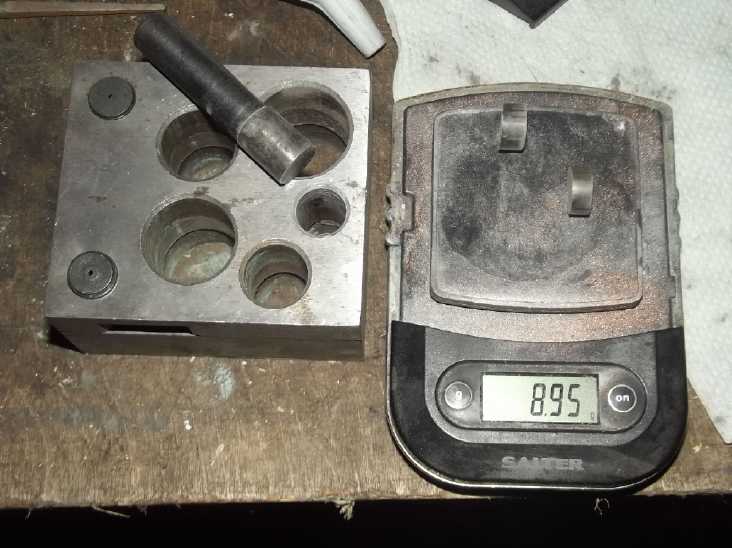 I compacted it
into two disks. I was harder to break up the pieces than with the
nickel oxide mix.
I compacted it
into two disks. I was harder to break up the pieces than with the
nickel oxide mix.
I put all the pieces in at once. This was a mistake, as
the bottom half didn't come out half as compacted as the top half - it
looked dull instead of shiny and pieces broke off. I decided to use it
anyway because it should be at least half good, and of sufficient
amp-hours capacity to prove the point.
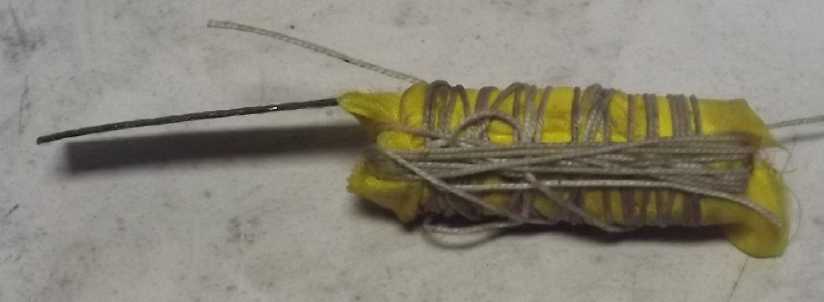 I put a piece of
UHMW(?) half inch rod on each end to give it some form and used a piece
of graphite foil on one side as a current collector. I put it in the
bottle cell, topped up the electrolyte, and left it to soak a while.
I put a piece of
UHMW(?) half inch rod on each end to give it some form and used a piece
of graphite foil on one side as a current collector. I put it in the
bottle cell, topped up the electrolyte, and left it to soak a while.
It didn't seem to work very well. The properties seemed a
little different than on other attempts and I should continue to test
it, but I decided I should have added graphite. Sigh!
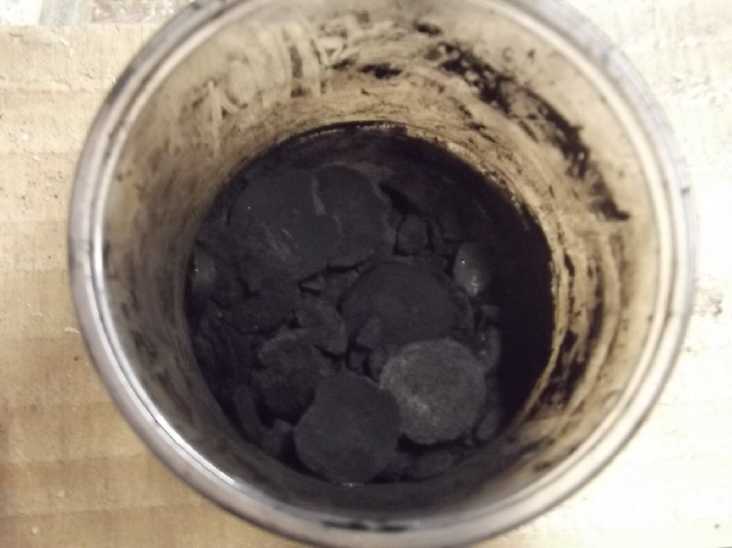 So I did
another one, again 10 g of monel, this time with 1.7 g of conductive
carbon black (CCB). The loose, fluffy CCB filled the little cup, but
after compacting once it was much smaller. After twice it was again
just a small amount in the bottom. But it didn't have the cohesion of
the pure monel, and broke readily into little bits.
So I did
another one, again 10 g of monel, this time with 1.7 g of conductive
carbon black (CCB). The loose, fluffy CCB filled the little cup, but
after compacting once it was much smaller. After twice it was again
just a small amount in the bottom. But it didn't have the cohesion of
the pure monel, and broke readily into little bits.
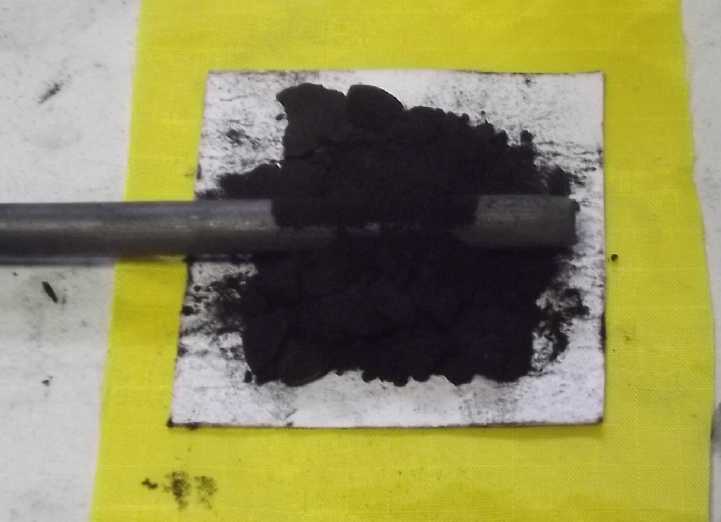 That
being
the
case,
I
wrapped
it
up with a 1/4 inch graphite rod in the center. I
wanted to test this one more than the other, so I swapped them. The
charge current (@ 1.5 V) again started small, but this time increased
to 20+mA over a few hours.
That
being
the
case,
I
wrapped
it
up with a 1/4 inch graphite rod in the center. I
wanted to test this one more than the other, so I swapped them. The
charge current (@ 1.5 V) again started small, but this time increased
to 20+mA over a few hours.

Performance wasn't good, but I checked with the reference
electrode and found that this time it was much more the zinc side that
was weak (losing voltage rapidly under load) rather than the copper.
Hopefully my osmium powder (ordered in May or June) is shipped and
arrives sometime soon so I can make a new zinc trode.
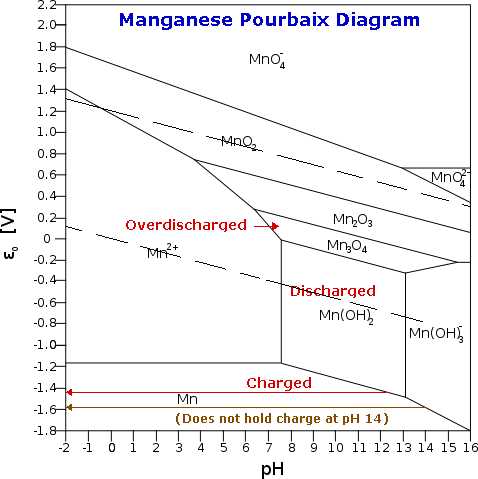 [6th] In the
morning the copper electrode seemed 'rock solid', losing voltage under
load only very slowly. But the zinc was no better. I decided to try the
manganese negative. I turned the charge up to 1.8V. After a couple of
hours charging it seemed to run a 50 Ω load at 1.044V, dropping by only
about 2 mV/minute. What were the Mn voltages, again?
[6th] In the
morning the copper electrode seemed 'rock solid', losing voltage under
load only very slowly. But the zinc was no better. I decided to try the
manganese negative. I turned the charge up to 1.8V. After a couple of
hours charging it seemed to run a 50 Ω load at 1.044V, dropping by only
about 2 mV/minute. What were the Mn voltages, again?
I considered that in all the months it had sat
unconnected, the Mn metal would have converted/discharged to Mn(OH)2 in
spite of the hydrogen overvoltage raising additives. But it might have
gone further to Mn3O4... or even to Mn2O3? -- which I now realize is an
insulator that won't recharge. (and I'm not sure about Mn3O4.)
None of the states of Mn
looked anywhere near -1V to make 1.045V under load with Cu(OH)2 at
about 0V. Where did such a voltage come from? Oh... The Mn electrode
used zinc as a conductivity additive. The zinc must be charging back to
metallic state and the voltage would be zinc-copper. The Mn would still
be (presumably) Mn(OH)2. Of course without the osmium cataliyst the
zinc wouldn't stand repeated cycling. But for the moment, it seemed to
be working well with the copper.
I turned the charge up to 2V to see if the Mn would charge
with some extra potential. But of course, it can't charge until the
zinc is fully charged.
Late in the afternoon it didn't seem to be holding "Mn"
level voltage, but neither trode was noticeably bubbling. I ran a 20'
load test (50Ω, ~18mA) and the voltage fell only from 1.108V to 1.072V
- a drop of less than 2mV/minute, so both electrodes seemed pretty
solid if considering the minus to be zinc. In addition the recovery was
much faster after the load was ended - in a few seconds it had risen
most of the way to 1.27X V and only rose a few more millivolts after
that. Previously they were still rising gradually a minute or two after
the load had ended.
IF the double-compacted copper continued to perform well,
it would be sure that the main problem all along had been lack of
compaction of the powers. Another 20' test in the evening yielded a
very similar result, in the range 1.040V to 1.025V but still at 18mA.
(fickle connections probably explain the difference.)
[7th] In the morning it was still working as well as the previous day.
Starting around 1.04V in half an hour it was down to .95V, but it was
the ersatz zinc that was losing voltage. The copper just sat there
saying +.88V on the reference electrode. (The figure itself doesn't
mean much since we don't know the exact voltage of the graphite
reference. What is meaningful is that it wasn't changing under load.
The negative reading on the zinc side dropped along with the cell
voltage.)
Hurrah, I have a battery! Super strong compaction of the
powder mix on two or even all three axies is the crucial piece I was
missing.
As long as I'm trying a manganese negative electrode... I
did have that chemistry working long ago. Now the Mn side was still
only charging to zinc voltage, and bubbling rather than charging the
Mn. I suspect the pH is a little too high for Mn to work, since there's
quite a bit of KOH in the mix to make the zincate work. I know it's
never worked at pH 14.
I mixed some new electrolyte in a new bottle with just
KCl. When I put the electrodes in the pH read about 11, since the
electrodes themselves were still wet with some higher pH electrolyte. I
imagine the copper will still work fine at a lower pH.
If that didn't work, I should probably try making a new Mn
trode and compact it like the copper. The zinc dissolves and reforms
during discharge and charge, but the manganese presumably stays in
solid form and needs to be compacted. It didn't seem to work.
Over the day I left the cell disconnected. In the evening
I charged it for an hour or so at 1.8V. It was still almost 50mA. A 50
Ω load test this time started out at 1.200V, 22mA and the voltage
dropped over 20' to around 1.175V, and after 30' to 1.135V. There's
considerable variation owing to flaky connections, but that's over
100mV higher than previous, and the zinc and copper both seemed strong.
After a little recharging at 1.5V, a brief test with 20 Ω started at
1.1V but of course dropped more quickly as it was supplying ~50mA.
All this seemed excellent, but there was a little pile of
green stuff under the new copper trode, and more stuff came off it when
I pulled it out for a look. What happened to that bright yellow nylon
cloth?
[8th] It still worked, but not as well. I shouldn't be surprised -
there was just as much stuffcoming out of the cell as yesterday, piling
up underneath. I think I can safely conclude that
a. They work well with sufficient compaction and only with sufficient
compaction, which is tons of force in two or three directions.
b. The powders swell up and decompact (either simply when wetted or
with cycling) if there is any space they can ooze into.
c. No amount of graphite makes up for unsufficient compaction.
d. Dry cell makers put them into metal cylinders for that reason - to
trap the substances and keep them compacted.
So... I still don't have a lasting cell. What next? I can
now compact the powders, albeit in a heavily labor intensive process
for tiny quantities. If they are then going to crumble easily, I think
the thing to do is to go back to the PVC pipes with holes in them.
Hopefully those are stong enough to prevent swelling. I'll put in the
outer paper and the carbon rod, and then drop in a little pre-compacted
powder at a time, and scrunch it down with a tube that fits over the
rod and inside the paper. HOPEFULLY I can do that without scrunching up
the paper or breaking the rod, while mashing the pre-compacted powder
in with little to no spaces for it to expand into. Maybe I should
double up the paper and double up the PP cloth I iron into it?
[28th] Positive electrodes... The electrodes that worked best of all
were the cupro-nickel sheets, but only until the surfaces started
degrading. They had the highest current capacities. What if the sheets
could be held "intact" and not allowed to expand anywhere? With a
graphite current collector?
My first thought was holding flat sheets together with a
sheet of graphite foil in the middle as a current collector. Well, I
already know how hard it is to keep flat electrodes from swelling. It
doesn't take much before they aren't working properly.
What about a fat (3/8") graphite rod with one wind of CuNi
sheet metal tight around it, wrapped in separator paper and then
wrapped with cloth and tied with string? I wonder how long that would
last?
I feel like there must be something stiff but porous that
could be wrapped around over the separator paper - but what? Then I had
the thought that one might heat up a perforated PVC tube until it
expands a bit, put the electrode inside, and then let it cool and
shrink until it's pressing hard on the substances inside. That might be
good to experiment with.
Electricity
Generation
My Solar Power System(s)
The Usual Daily/Monthly/Yearly Log
of Solar Power Generated [and grid power consumed]
(All times are in PST: clock ~48 minutes ahead of local sun
time, never PDT which is an hour and 48 minutes ahead. (DC) battery
system power output readings are reset to zero daily (often just for
LED lights, occasionally used with other loads: Chevy Sprint electric
car, inverters in power outages or other 36V loads), while the grid
tied readings are cumulative.)
Daily Figures
Notes: House Main meter (6 digits) accumulates. DC meter now
accumulates until [before] it loses precision (9.999 WH => 0010
KWH), then is reset. House East and Cabin meters (4 digits) are reset
to 0 when they get near 99.99 (which goes to "100.0") - owing to loss
of second decimal precision.
Km = Nissan Leaf electric car drove distance, then car was charged.
New Order of Daily Solar Readings (Beginning May 2022):
New notation (from Sept. 2024): Same solar panels running grid ties +
DC battery system are grouped with "+" sign instead of just comma
separators. Nothing actually changes.
Date House+House, House, Cabin+Cabin => Total KWH Solar [Notable
power Uses (EV); Grid power meter@time] Sky/weather
Main
DC (carport)
AC DC
August
31st 2034.51, 3.87, 32.79, 19.73+1.25=>20.60 [55Km; 16520@20:00;50Km]
September
1st 2036.95, 3.90, 34.32, 20.07+1.10=> 5.44
[45Km; 16546@19:30]
2d 2041.58, 3.94, 37.12, 21.69+2.10=> 11.19
[16553@19:30] Actually the DC didn't completely recharge until 3rd, so
maybe ~1KWH too high, making 3rd ~1KWH too low. I'm not going to try to
guess and apportion it. (The 3rd was sunny and I shut off the grid ties
part of the day to make sure it recharged. It was charging at up to 20
amps, 800 watts. With 250W of heat, it takes just 1 hour of that to
make up for 3 hours of nighttime heating, but of course charging slows
once the max, 39.9V, is reached.
3rd 2050.26, 3.98, 42.62, 23.83+1.20=> 17.56 [45Km;
16565@20:30] Owing to the unrecharged battery I ran only 150W heater.
It was cold and the room got down to 15°C before morning. But the 3rd
was quite warm.
4th 2059.86, 3.01, 48.46, 26.25+2.00 => 19.89 [55Km;
16577@21:00] Another glorious warm day after a chilly night.
5th 2062.71, 4.04, 50.13, 26.42+1.80 => 6.52
[16588@20:30]
6th 2066.26, 4.07, 52.50, 27.69+ .20 => 7.52
[85Km; 16607@20:00]
7th 2068.48, 4.12, 54.12, 27.76+2.20 => 6.16
[55Km; 16627@20:00; 50Km]
8th 2073.11, 4.19, 57.04, 27.78+ .40 =>
8.04 [35Km; 16644@19:30]
9th 2079.33, 4.24, 61.19, 28.71+1.20 => 12.55 [55Km; laundry;
16668@19:30]
10th 2082.48, 4.28, 63.21, 29.06+1.20 => 6.79 [60Km;
16682@19:30]
11th 2091.12, 4.31, 68.58, 30.82+2.00 => 17.80
[16692@19:00]
12th 2093.96+4.39, 70.41, 30.90+1.46*=> 6.29 [16706@19:30]
*DC Power monitor installed. It should be noted that this meter
measures the consumption, not the generation. However, consumption is
about the same as generation over 2 or 3 days.
13th 2098.70+4.43, 73.47, 31.87+2.28 => 9.03 [85Km;
16727@19:30] From here on DC readings progress and previous day
must be subtracted.
14th 2103.67+4.48, 76.68, 32.45+4.28 => 10.81 [55Km; 16748@19:00;
50Km]
15th 2107.17+4.52, 79.01, 32.47+6.61 => 8.42 [35Km;
16777@21:30]
16th 2108.85+4.59, 79.95, 32.49+8.46 => 4.56
[16805@23:30]
17th 2116.90+4.69, 85.85, 34.23+1.60 => 17.39 [16811@19:30]
18th 2119.15+5.30, 87.80, 24.32+3.59 => 6.89 [55Km;
16833@19:30]
19th est 7.55
20th 2124.73+5.87, 92.12, 34.35+8.20 => 7.56 [85Km;
16894@19:00] 15.11 2 days
21st est 4.65
22d 2128.36+5.94, 94.69, 34.39+3.00 => 4.66
[16933@19:00] 9.31 2 days
23rd 2129.82+6.00, .91, 34.41+3.13
=> 2.58 [50Km; 16966@19:00]
24th 2131.94+6.04, 2.81, 34.42+4.85 => 5.79
[16986@19:30]
25th 2137.31+6.07, 7.17, 34.44+6.51 => 11.42 [55Km;
17017@21:00] Yay, a little sunshine!
26th 2137.54+6.13, 7.26, 34.46+8.71 => 2.58
[17061@24:00] Rain, Reign, Rain! -- This is skewed by measuring DC KWH
out in the cabin instead of KWH in
27th 2143.45+6.18, 11.63, 35.39+ .04 => 11.30 [90Km;
17081@19:00] Some sun! -- Ditto. That 2 KWH used yesterday was
recharged today
28th 2150.25+6.22, 16.93, 37.14+1.66 => 15.55 [55Km; 17112@21:30;
50Km] Sun, rain almost end of day
29th 2154.39+6.30, 20.82, 38.81+3.84 => 10.29 [90Km; 17158@23:30]
30th 2155.49+6.36, 21.60, 38.83+4.38 => 2.50
[17182@21:00]
October
1st 2157.85+6.39, 23.04, 38.85+6.43 =>
5.90 [50Km; 17214@19:30]
2nd 2163.04+6.42, 27.23, 40.87+6.43 => 11.43 [17250@'24:30']
3rd 2165.30+6.47, 28.56, 40.94+7.13 => 4.41
[17279@22:30]
4th 2170.18+6.55, 32.32, 43.0*+7.6* => 11.25 [90Km;
16307@19:30] *estimated
5th 2174.68+6.58, 35.48, 44.92+8.37 => 10.38 [55Km;
17333@20:30; 50Km]
6th 2175.94+6.62, 36.32, 44.94, 0.04 => 2.20
[50Km; 17374@19:30]
7th 2180.29+6.69, 39.65, 44.96+2.31 => 10.08 [17392@18:30]
Chart of daily KWH from solar panels. (Compare September 2024 with August 2024 & with
September 2023.)
Days of
__ KWH
|
September
2024
(18 C's)
|
August 2024
(18 C's)
|
September 2023
(18 Collectors)
|
0.xx
|
|
|
|
1.xx
|
|
|
|
2.xx
|
2
|
|
|
3.xx
|
|
1
|
1
|
4.xx
|
3
|
|
2
|
5.xx
|
2
|
|
2
|
6.xx
|
5
|
2
|
2
|
7.xx
|
3
|
1
|
2
|
8.xx
|
2
|
|
2
|
9.xx
|
1
|
|
3
|
10.xx
|
2
|
2
|
2
|
11.xx
|
3
|
3
|
4
|
12.xx
|
1
|
1
|
3
|
13.xx
|
|
1
|
1 |
14.xx
|
|
1
|
4
|
15.xx
|
1
|
2
|
|
16.xx
|
|
1
|
1
|
17.xx
|
3
|
1
|
|
18.xx
|
|
1
|
|
19.xx
|
1
|
1
|
|
20.xx
|
|
3
|
|
21.xx
|
|
1
|
|
22.xx
|
|
1
|
|
23.xx
|
|
2
|
|
24.xx
|
|
3
|
|
25.xx
|
|
3
|
|
Total KWH
for month
|
266.02 |
524.56
|
406.20
|
Km Driven
on Electricity
|
1210.5 Km
~155 KWH
|
1420.2 Km
~180 KWH
|
1190 Km
(~165 KWH?)
|
Things Noted - September 2024
* I note that August, with much sunny weather until the last week, was
record solar power for August (and for 2024).
Monthly Summaries: Solar Generated KWH [& Power used
from grid KWH]
As these tables are getting long, I'm not repeating the log of monthly
reports. The reports for the first FIVE full years (March 2019 to
February 2024) may be found in TE
News
#189,
February
2024.
2024
Month: HouseAC + DC +Carport+Cabin[+DC (from Aug 2024)
Jan KWH: 31.37 + 3.14 + 16.85 + 16.82 = 68.18 [grid:
909; car (very rough estimates): 160]
Feb KWH: 96.52 + 2.36 + 49.67 + 52.98 = 201.53 [grid: 791; car:
130]
FIVE full Years of solar!
Mar KWH 150.09+ 1.63 + 93.59 + 92.50 = 337.81 [grid: 717; car:
140]
Apr KWH 181.89+35.55 +123.50+142.74 = 483.68 [grid: 575; car: 140]
May KWH 129.23+67.38 +109.6 +126.32 = 432.53 [grid: 405; car: 145]
Jun KWH 152.54+51.02+118.99+141.17 = 463.72 [grid: 420; car: 190]
July KWH 174.22+30.53+111.19+128.62 = 444.56 [grid: 386; car: 165]
Aug KWH 221.99+ 2.63 +142.49+151.67+ 5.78 = 524.56 [grid 358; car
180]
SeptKWH 120.98+ 2.49 + 83.50 + 19.10+ 39.95 = 266.02 [grid used: 662
(yowr!); car 155*]
* Car consumption came from solar and or grid: it does not add to other
figures.
Annual Totals
1. March 2019-Feb. 2020: 2196.15 KWH Solar [used 7927 KWH
from grid; EV use: -] 10, 11, 12 solar panels
2. March 2020-Feb. 2021: 2069.82 KWH Solar [used 11294 KWH from grid;
EV use: - (More electric heat - BR, Trailer & Perry's RV)] 12 solar
panels
3. March 2021-Feb. 2022: 2063.05 KWH Solar [used 10977 KWH from grid;
EV use ~~1485 KWH] 12 solar panels, 14 near end of year.
4a. March 2022-August 2022: in (the best) 6 months, about 2725 KWH
solar - more than in any previous entire year!
4. March2022-Feb. 2023: 3793.37 KWH Solar [used 12038 KWH from grid; EV
use: ~1583 KWH] 14, 15, 18 solar panels
5. March 2023-Feb. 2024: 3891.35 KWH Solar [used 7914 KWH from power
grid; EV use: ~1515 KWH] 18 solar panels
Money Saved or Earned - @ 12¢ [All BC residential elec. rate] ;
@ 50¢ [2018 cost of diesel fuel to BC Hydro] ; @ 1$ per KWH [actual
total cost to BC Hydro in 2022 according to an employee]; or 62 ¢/KWH
[according to BC Hydro at Renewable Energy Symposium Sept. 2024]:
1. 263.42$ ; 1097.58$ ; 2196.15$
2. 248.38$ ; 1034.91$ ; 2069.82$
3. 247.57$ ; 1031.53$ ; 2063.05$
4. 455.20$ ; 1896.69$ ; 3793.37$
5. 466.96$ ; 1945.68$ ; 3891.35$
It can be seen that the benefit to the society as a whole
on Haida Gwaii from solar power installations is much greater than the
cost savings to the individual user of electricity, thanks to the heavy
subsidization of our power owing to the BC government policy of having
the same power rate across the entire province regardless of the cost
of production. And it can be insurance: With some extra equipment and a
battery, sufficient solar can deliver essential power in electrical
outages however long. (Feb 28th 2023: And it's probably well over
1$/KWH by now the way inflation of diesel fuel and other costs is
running.)
It might also be noted that I never went into this in a
big way. Instead of installing a whole palette load of 32 solar panels,
I have 18, and my grid ties aren't the best, and I would be hard put to
give an accurate total of my installation costs. All in all the grid
tied part probably cost me (with all my own 'free' labor) around 7000$.
At the actual "total savings to all" figures, they have paid for
themselves twice over in five years. The 36V DC system largely cost a
couple of thousand dollars for batteries. The solar panels were up. The
charge controller, circuit breakers, DC combo meters [V, A, W, WH], 36V
compatible LED lights and wiring cost were a few hundred dollars at
most. (I did have to make my own T-Plug cables & 3D printed wall
plates.) The battery cost has come down substantially in recent years
and will come down a lot more if I can get cheap, "forever cycle"
batteries working.
http://www.TurquoiseEnergy.com
Haida Gwaii, BC Canada



 Friends sold me
some beautiful 12 by 24 inch vinyl floor tiles, 1/2 inch thick with
slots around the edges. They had been sitting around for some years,
new in boxes, and I was fortunate to get them for a great price. There
were enough to do my entire cabin!
Friends sold me
some beautiful 12 by 24 inch vinyl floor tiles, 1/2 inch thick with
slots around the edges. They had been sitting around for some years,
new in boxes, and I was fortunate to get them for a great price. There
were enough to do my entire cabin!





 A couple of years
ago I had the idea to insulate the cabin with dried lawn grass
clippings. As a loose fill it's about R3 per inch, slightly lower than
fiberglass, free, and biodegradable. [TE News #169, #170] I
collected 50 large bags over the summer. Then I decided it wasn't good
enough and I would use cellulose fiber (R4 per inch). I started using
my bags of dried clippings for mulch and to put in the chicken coop. By
the time I discovered I literally could not buy cellulose fiber
insulation in northern BC, I had used most of the clippings and was
stuck with using fiberglass.
A couple of years
ago I had the idea to insulate the cabin with dried lawn grass
clippings. As a loose fill it's about R3 per inch, slightly lower than
fiberglass, free, and biodegradable. [TE News #169, #170] I
collected 50 large bags over the summer. Then I decided it wasn't good
enough and I would use cellulose fiber (R4 per inch). I started using
my bags of dried clippings for mulch and to put in the chicken coop. By
the time I discovered I literally could not buy cellulose fiber
insulation in northern BC, I had used most of the clippings and was
stuck with using fiberglass. My 3D printer
being on the fritz, I have some 36V plugs with no shell covering them.
I plugged one in. My thumb and finger were touching both plus and minus
pins and after I thought "Ooh, my fingers were damp." But I didn't get
a shock. No one would dare even think to use a plug with bare wires
with 120 volts, where such casual mistakes can potentially be fatal! I
suspect I'd have got a shock at 48 volts.
My 3D printer
being on the fritz, I have some 36V plugs with no shell covering them.
I plugged one in. My thumb and finger were touching both plus and minus
pins and after I thought "Ooh, my fingers were damp." But I didn't get
a shock. No one would dare even think to use a plug with bare wires
with 120 volts, where such casual mistakes can potentially be fatal! I
suspect I'd have got a shock at 48 volts.
 Having got the
first 11 boxes of floor tiles, I spent two days installing them in my
cabin bedroom [8th & 9th]. These were 1/2 inch thick interlocking
vinyl tiles. Slight texture so as not to be slick when wet. No glue,
"cushiony" with a small insulating air space, "waterproof". Set them
side by side and pound the groove of one into into the tongue of the
other with a rubber or wooden hammer until they are flush. (You can pry
them apart again if necessary. Any slight bit of grit in the grooves
they won't go down flush.) Of course it made a tremendous difference to
the whole appearance of the room from rough T & G boards. And it
covered over knot holes in the boards.
Having got the
first 11 boxes of floor tiles, I spent two days installing them in my
cabin bedroom [8th & 9th]. These were 1/2 inch thick interlocking
vinyl tiles. Slight texture so as not to be slick when wet. No glue,
"cushiony" with a small insulating air space, "waterproof". Set them
side by side and pound the groove of one into into the tongue of the
other with a rubber or wooden hammer until they are flush. (You can pry
them apart again if necessary. Any slight bit of grit in the grooves
they won't go down flush.) Of course it made a tremendous difference to
the whole appearance of the room from rough T & G boards. And it
covered over knot holes in the boards. [15th]
The
battery
got
rather
run
down
in
the night, below 36 volts. I can't depend on solar for
heating in the cloudy winter months with short days and long tree
shadows obscuring the panels. But rather than being driven into the
house or turning on a noisy AC heater, I "installed" a 10 amp power
supply on the one outlet by the door, set to 38 volts. I used a diode
with a heat sink to isolate the supply, which fed the battery with a
long DC cable. As the battery drained from 39.9 volts down to 38.0, the
power supply would draw from the AC line to keep it from dropping
further. I could turn on all the small heaters for the night "with
impunity". If the sun could bring it back up to 39.9 volts, then it
would be mostly solar the next night.
[15th]
The
battery
got
rather
run
down
in
the night, below 36 volts. I can't depend on solar for
heating in the cloudy winter months with short days and long tree
shadows obscuring the panels. But rather than being driven into the
house or turning on a noisy AC heater, I "installed" a 10 amp power
supply on the one outlet by the door, set to 38 volts. I used a diode
with a heat sink to isolate the supply, which fed the battery with a
long DC cable. As the battery drained from 39.9 volts down to 38.0, the
power supply would draw from the AC line to keep it from dropping
further. I could turn on all the small heaters for the night "with
impunity". If the sun could bring it back up to 39.9 volts, then it
would be mostly solar the next night.










 I compacted it
into two disks. I was harder to break up the pieces than with the
nickel oxide mix.
I compacted it
into two disks. I was harder to break up the pieces than with the
nickel oxide mix. I put a piece of
UHMW(?) half inch rod on each end to give it some form and used a piece
of graphite foil on one side as a current collector. I put it in the
bottle cell, topped up the electrolyte, and left it to soak a while.
I put a piece of
UHMW(?) half inch rod on each end to give it some form and used a piece
of graphite foil on one side as a current collector. I put it in the
bottle cell, topped up the electrolyte, and left it to soak a while. So I did
another one, again 10 g of monel, this time with 1.7 g of conductive
carbon black (CCB). The loose, fluffy CCB filled the little cup, but
after compacting once it was much smaller. After twice it was again
just a small amount in the bottom. But it didn't have the cohesion of
the pure monel, and broke readily into little bits.
So I did
another one, again 10 g of monel, this time with 1.7 g of conductive
carbon black (CCB). The loose, fluffy CCB filled the little cup, but
after compacting once it was much smaller. After twice it was again
just a small amount in the bottom. But it didn't have the cohesion of
the pure monel, and broke readily into little bits. That
being
the
case,
I
wrapped
it
up with a 1/4 inch graphite rod in the center. I
wanted to test this one more than the other, so I swapped them. The
charge current (@ 1.5 V) again started small, but this time increased
to 20+mA over a few hours.
That
being
the
case,
I
wrapped
it
up with a 1/4 inch graphite rod in the center. I
wanted to test this one more than the other, so I swapped them. The
charge current (@ 1.5 V) again started small, but this time increased
to 20+mA over a few hours.
 [6th] In the
morning the copper electrode seemed 'rock solid', losing voltage under
load only very slowly. But the zinc was no better. I decided to try the
manganese negative. I turned the charge up to 1.8V. After a couple of
hours charging it seemed to run a 50 Ω load at 1.044V, dropping by only
about 2 mV/minute. What were the Mn voltages, again?
[6th] In the
morning the copper electrode seemed 'rock solid', losing voltage under
load only very slowly. But the zinc was no better. I decided to try the
manganese negative. I turned the charge up to 1.8V. After a couple of
hours charging it seemed to run a 50 Ω load at 1.044V, dropping by only
about 2 mV/minute. What were the Mn voltages, again?